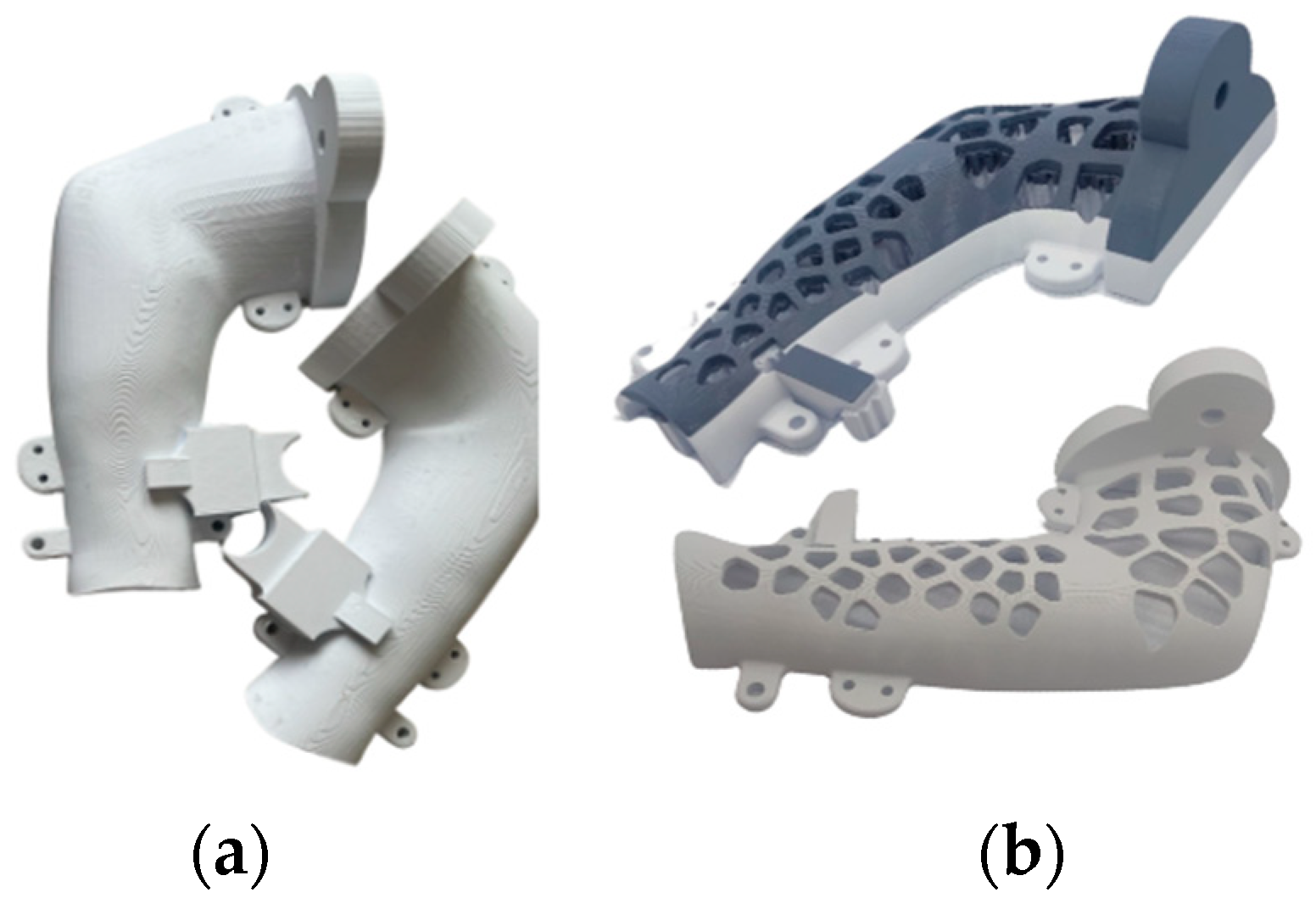Development of a Customized 3D Printed Orthosis for Non-Surgical Treatment of Olecranon Elbow Fractures †
Abstract
:1. Introduction
2. Methodology
2.1. Orthosis Design Process
2.2. Material Selection and Characterization
2.2.1. Tensile Test
2.2.2. Simultaneous Thermal Analysis (STA)
2.3. 3D Scanning and MESH
2.4. 3D Design
2.4.1. Voronoi Diagrams in Fusion 360
2.4.2. 3D Design of the Orthosis in Fusion 360
Design of the Final Orthosis
Design of the Orthosis for Mechanical Testing
2.5. Elbow Orthosis Manufacturing and 3D Printing
2.6. Mechanical Tests and Evaluations
3. Results and Discussion
3.1. Material Characterization
3.1.1. Tensile Test
3.1.2. Simultaneous Thermal Analysis (STA)
3.2. Orthosis Results
4. Conclusions
Author Contributions
Funding
Institutional Review Board Statement
Informed Consent Statement
Data Availability Statement
Acknowledgments
Conflicts of Interest
References
- Instituto Mexicano del Seguro Social. Coordinación de Unidades Médicas de alta Especialidad. Diagnóstico y Tratamiento de Lesiones Traumáticas de codo en Adultos. Available online: https://www.imss.gob.mx/sites/all/statics/guiasclinicas/198GE.pdf (accessed on 8 August 2023).
- Baecher, N.; Edwards, S. Olecranon fractures. J. Hand Surg. 2013, 38, 593–604. [Google Scholar] [CrossRef]
- Wiegand, L.; Bernstein, J.; Ahn, J. Fractures in brief: Olecranon fractures. Clin. Orthop. Relat. Res. 2012, 470, 3637–3641. [Google Scholar] [CrossRef] [PubMed]
- Jayakumar, P.; Teunis, T.; Vranceanu, A.M.; Moore, M.G.; Williams, M.; Lamb, S.; Ring, D.; Gwilym, S. Psychosocial factors affecting variation in patient-reported outcomes after elbow fractures. J. Shoulder Elb. Surg. 2019, 28, 1431–1440. [Google Scholar] [CrossRef]
- Sullivan, C.W.; Desai, K. Classifications in Brief: Mayo Classification of Olecranon Fractures. Clin. Orthop. Relat. Res. 2019, 477, 908–910. [Google Scholar] [CrossRef] [PubMed] [PubMed Central]
- Cantore, M.; Candela, V.; Sessa, P.; Giannicola, G.; Gumina, S. Epidemiology of isolated olecranon fractures: A detailed survey on a large sample of patients in a suburban area. JSES Int. 2022, 6, 309–314. [Google Scholar] [CrossRef] [PubMed]
- Bergström, J.S.; Hayman, D. An overview of mechanical properties and material modeling of polylactide (PLA) for medical applications. Ann. Biomed. Eng. 2016, 44, 330–340. [Google Scholar] [CrossRef] [PubMed]
- Sood, A.K.; Ohdar, R.K.; Mahapatra, S.S. Improving dimensional accuracy of fused deposition modelling processed part using grey Taguchi method. Mater. Des. 2010, 31, 2877–2884. [Google Scholar] [CrossRef]
- Gupta, A.; Kumar, A.; Kumar, V. A review on 3D printing materials and their sustainability. Mater. Today Proc. 2019, 18, 4379–4389. [Google Scholar]
- Hosford, W.F. Tensile Testing. In Mechanical Behavior of Materials; Cambridge University Press: Cambridge, UK, 2005; pp. 39–52. [Google Scholar]
- Differential Thermogravimetric Analysis. Available online: https://www.sciencedirect.com/topics/chemistry/differential-thermogravimetric-analysis (accessed on 1 December 2023).
- 3D Systems Support. Available online: https://support.3dsystems.com/s/article/Sense-Scanner?language=en_US (accessed on 9 December 2023).
- Voronoi Diagram. Voronoi Diagram—An Overview | ScienceDirect Topics. Available online: https://www.sciencedirect.com/topics/earth-and-planetary-sciences/voronoi-diagram (accessed on 3 December 2023).
- Voronoi Diagram from Wolfram MathWorld. Available online: https://mathworld.wolfram.com/VoronoiDiagram.html (accessed on 3 December 2023).
- Lau, C. The Voronoi theory of the normal liver lobular architecture and its applicability in hepatic zonation. Sci. Rep. 2021, 11, 9343. [Google Scholar] [CrossRef] [PubMed]
- Alknery, Z.; Sktani, Z.; Arab, A. Effect of cell geometry on the mechanical properties of 3D Voronoi tessellation. J. Funct. Biomater. 2022, 13, 302. [Google Scholar] [CrossRef]
- Zhao, H. Design and mechanical properties verification of gradient Voronoi scaffold for bone tissue engineering. Micromachines 2021, 12, 664. [Google Scholar] [CrossRef] [PubMed]
- Weydemann, L.; Clemenz, C.; Preisinger, C. On the structural properties of Voronoi diagrams. KoG 2021, 1, 72–77. [Google Scholar] [CrossRef]
- Ricotta, V.; Campbell, R.I.; Ingrassia, T.; Nigrelli, V. A new design approach for customized medical devices realized by additive manufacturing. Int. J. Interact. Des. Manuf. (IJIDeM) 2020, 14, 1171–1178. [Google Scholar] [CrossRef]
- PLA, Polylactic Acid, 3D Printing Filament, 1.75 mm Diameter. MatWeb Material Property Data. Available online: https://www.matweb.com/search/DataSheet.aspx?MatGUID=ab96a4c0655c4018a8785ac4031b9278&ckck=1 (accessed on 5 December 2023).








| Parameter | Value |
|---|---|
| Layer Height | 0.32 mm |
| Infill Density | 15% |
| Print Speed | 65 mm/s |
| Top Layers | 3 |
| Bottom Layers | 4 |
| Printing Temperature | 215 °C |
| Young Modulus (MPa) | Maximum Force (N) | Tensile Strength (MPa) | |
|---|---|---|---|
| Average of 12 specimens | 2.9 | 103 | 43 |
| Maximum Force (N) | Maximum Force (kgf) | |
|---|---|---|
| Orthosis with holes | 1303 | 132.8 |
| Orthosis without holes | 812 | 82.7 |
Disclaimer/Publisher’s Note: The statements, opinions and data contained in all publications are solely those of the individual author(s) and contributor(s) and not of MDPI and/or the editor(s). MDPI and/or the editor(s) disclaim responsibility for any injury to people or property resulting from any ideas, methods, instructions or products referred to in the content. |
© 2025 by the authors. Licensee MDPI, Basel, Switzerland. This article is an open access article distributed under the terms and conditions of the Creative Commons Attribution (CC BY) license (https://creativecommons.org/licenses/by/4.0/).
Share and Cite
Rodriguez, D.; Boggio, C.; Cama, M.; Torres, J.; Ccama, G.; Ochoa, E.; Molina, A.R. Development of a Customized 3D Printed Orthosis for Non-Surgical Treatment of Olecranon Elbow Fractures. Eng. Proc. 2025, 83, 23. https://doi.org/10.3390/engproc2025083023
Rodriguez D, Boggio C, Cama M, Torres J, Ccama G, Ochoa E, Molina AR. Development of a Customized 3D Printed Orthosis for Non-Surgical Treatment of Olecranon Elbow Fractures. Engineering Proceedings. 2025; 83(1):23. https://doi.org/10.3390/engproc2025083023
Chicago/Turabian StyleRodriguez, Dante, Catherine Boggio, Melany Cama, Joao Torres, Gianella Ccama, Emilio Ochoa, and Andoni R. Molina. 2025. "Development of a Customized 3D Printed Orthosis for Non-Surgical Treatment of Olecranon Elbow Fractures" Engineering Proceedings 83, no. 1: 23. https://doi.org/10.3390/engproc2025083023
APA StyleRodriguez, D., Boggio, C., Cama, M., Torres, J., Ccama, G., Ochoa, E., & Molina, A. R. (2025). Development of a Customized 3D Printed Orthosis for Non-Surgical Treatment of Olecranon Elbow Fractures. Engineering Proceedings, 83(1), 23. https://doi.org/10.3390/engproc2025083023






